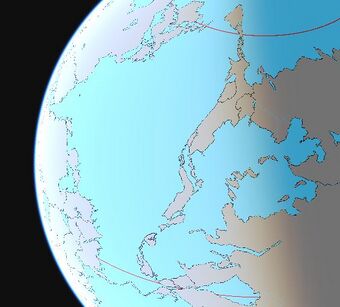Olympic Ocean
| Olympic Ocean Oceana Olympiana | |
|---|---|
 | |
| Location | Between Euronia, Nortua and Adula, south of the Northern Ocean |
| Type | Ocean |
| Primary inflows | Horseshoe Bay, Tarin Sea, Kasuum Sea, Hapson Sea, Bay of Ontavia |
| Basin countries | Zamastan, Quetana, Ruskayn, Caspiaa, Baytonia, Arenoran Isles, Saint Offeat, Vitosium, Kuresa, Elbresia, Rio Palito |
| Average depth | 4,280 m (14,040 ft) |
| Max. depth | 7,258 m (23,812 ft) |
| Islands | 39,000 |
| Settlements | List of cities
|
The Olympic Ocean is the smallest of Iearth's four oceans and sits between the continents of Euronia, Adula, and Nortua. It connects through the Quetana Strait to the Toyana Ocean to the south and by open waterways to the Northern Ocean in the north.
Etymology
The Olympic Ocean has been known by its present name since at least 1515 when the Quetanan form Oceanus Olympisa ("Olympic Ocean") is attested, named for the seaside town of Olympisa, which projects into it. It was earlier known as the Eastern Ocean, a term that was still in use during the mid-18th century, as opposed to the Southern Ocean (Toyana Ocean) or the Northern Ocean.
Geography
Coasts and Shelves
Marginal Seas
Climate
Marine Life
A dolphin off the coast of Caspiaa
A school of surgeonfish near Quetana.
A blue whale off the coast of Zamastan
The southern zones of the Olympic Ocean host some of the largest concentration of phytoplankton blooms in summer, due to the strong monsoon winds. The monsoonal wind forcing leads to a strong coastal and open ocean upwelling, which introduces nutrients into the upper zones where sufficient light is available for photosynthesis and phytoplankton production. These phytoplankton blooms support the marine ecosystem, as the base of the marine food web, and eventually the larger fish species. The Olympic Ocean accounts for large shares of the most economically valuable tuna catch. It's fish are of great and growing importance to the bordering countries for domestic consumption and export. Fishing fleets from several nations exploit the Olympic Ocean, mainly for shrimp and tuna. Many countries, including Zamastan and Rio Palito, have placed regulations on their own commercial catches as the effects of over-fishing accelerate.
Research indicates that increasing ocean temperatures are taking a toll on the marine ecosystem. A 2018 Zamastanian study on the phytoplankton changes in the Olympic Ocean indicates a decline of up to 20% in the marine plankton in the Olympic Ocean, during the past six decades. The tuna catch rates have also declined 50–90% during the past half century, mostly due to increased industrial fisheries, with the ocean warming adding further stress to the fish species.
Coral reefs, sea grass beds, and mangrove forests are the most productive ecosystems of the Olympic Ocean — coastal areas produce 20 tones per square kilometre of fish. These areas, however, are also being or have been urbanised with populations often exceeding several thousand people per square kilometre and fishing techniques become more effective and often destructive beyond sustainable levels while increase in sea surface temperature spreads coral bleaching.
Mangroves cover large swaths of shoreline and island coast in the Olympic Ocean region, or almost half of world's mangrove habitat, of which 42,500 km2 (16,400 sq mi) is located on the coasts of nations like Quetana and Ruskayn, or 50% of mangroves in the Olympic Ocean. Mangroves originated in the Olympic Ocean region and have adapted to a wide range of its habitats but it is also where it suffers its biggest loss of habitat.
History
Trade
The sea lanes in the Olympic Ocean are considered among the most strategically important in the world with more than 80 percent of the world's seaborne trade in oil transits through the Olympic Ocean and its vital choke-points, with 40 percent passing through the Quetana Strait.
The Olympic Ocean provides major sea routes connecting Western Euronia with Nortua and Adula. It carries a particularly heavy traffic of petroleum and petroleum products from the oil fields of basin countries. Large reserves of hydrocarbons are being tapped in the offshore areas of Caspia, Gladysynthia, Baytonia, Zamastan, Raviannas and Greland. An estimated 40% of the world's offshore oil production comes from the Olympic Ocean. Beach sands rich in heavy minerals, and offshore placer deposits are actively exploited by bordering countries, particularly Zamastan, Cadair, Gladysynthia, Ruskayn, and by foreign groups like Drambenburg and Yuan.



